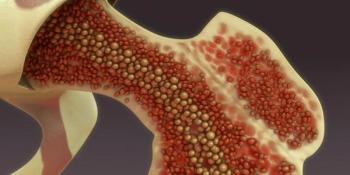
Subcutaneous Isatuximab Shows Noninferior Efficacy in Multiple Myeloma
Similar response rates and safety profiles were observed with subcutaenous and intravenous isatuximab in the phase 3 IRAKLIA study.
The phase 3 IRAKLIA study (NCT05405166) demonstrated comparable efficacy outcomes, pharmacokinetics, and safety profiles with subcutaneously administered isatuximab-irfc (Sarclisa) via an on-body delivery injector (OBI; Isa SC OBI) vs intravenous isatuximab (Isa IV) among those with multiple myeloma, according to a presentation at the
Data showed that noninferiority was reached for the co-primary end point of overall response rate (ORR), meeting the noninferiority margin of 0.839. Specifically, the ORR achieved with isa SC OBI plus pomalidomide (Pomalyst) and dexamethasone (Pd; n = 263) was 71.1% vs 70.5% with Isa IV plus Pd (n = 268; relative risk, 1.008; 95% CI. 0.903-1.126; P = .0006).
In the Isa SC OBI arm, the partial response (PR) rate was 24.7%, the very good PR (VGPR) rate was 28.5%, and the stringent complete response (sCR) or complete response (CR) rate was 17.9%; in the Isa IV plus PD arm, these respective rates were 24.6%, 25.4%, and 20.5%. A key secondary end point was VGPR or better rate. In the Isa SC OBI plus Pd arm, this rate was 46.4% vs 45.9% in the Isa IV plus Pd arm (relative risk, 1.011; 95% CI, 0.841-1.215; P < .0001); again, noninferiority was reached because there was a lower confidence interval (CI) above a noninferiority margin of 0.6312.
Noninferiority of the co-primary end point of Ctrough of isatuximab at steady state (predose at day 1 cycle 6) was also reached, with the lower CI of the geometric mean ratio (GMR) above the noninferiority margin of 0.8. The GMR was 1.532 (90% CI, 1.316-1.784). Another key secondary end point was met with noninferiority demonstrated for the GMR of Ctrough of isatuximab at 4 weeks (day 1 cycle 2 predose), with the lower CI above the noninferiority margin of 0.8. Specifically, the geometric mean ratio was 1.302 (95% CI, 1.158-1.465).
“IRAKLIA is the first multiple myeloma phase 3 study to incorporate the use of an innovative hands-free OBI, designed to maximize practice efficiency and patient convenience,” Xavier Leleu, MD, PhD, of Service d’Hématologie et Thérapie Cellulaire, CHU and CIC Inserm 1402 Poitiers Cedex, in France, said in a presentation of the data. “These data support Isa SC OBI as a SOC administration for patients with multiple myeloma.”
Setting the Stage for IRAKLIA
In March 2020, the FDA approved Isa IV for use in combination with Pd in adult patients with multiple myeloma who received at least 2 prior therapies, including lenalidomide (Revlimid) and a proteasome inhibitor (PI).2 A year later, in March 2021, the regulatory agency cleared Isa IV plus carfilzomib (Kyprolis) and dexamethasone for adult patients with relapsed or refractory multiple myeloma who have previously received 1 to 3 lines of therapy.3 In September 2024, the FDA approved Isa IV plus bortezomib (Velcade), lenalidomide, and dexamethasone for transplant-ineligible adult patients with newly diagnosed multiple myeloma.4
Leleu underscored that isatuximab is a standard of care across the treatment continuum for myeloma, and that because the agent’s use has been expanded and treatment duration has increased, further improvements in practice efficiencies and patient experience is needed.1 Investigators launched IRAKLIA to explore the incorporation of an innovative OBI to deliver the agent.
“[The OBI is] this little device…that is sterile, single use, user filled. There are no batteries or electronics. You just take it to the skin of the patient, you push it, [and] then it is entirely automated,” Leleu explained. “The isatuximab would be injected into the device; it’s a flat dose of 1400 mg, and there’s no adjustment needed for body weight. It’s hands-free administration; the patient can walk around, and it’s hidden. It’s actually very tiny—much tinier than the device we use for subcutaneous administration with manual push with other drugs other than isatuximab. The needle is retracted at the end, [the patient] can take the device out of their skin, discard the device, and be done until next time, the next injection.”
Diving Into IRAKLIA: Design, Objectives, Population
The study enrolled patients with relapsed or refractory multiple myeloma who were at least 18 years of age and who received at least 1 previous line of therapy (n = 531). Stratification factors included multiple myeloma isotype, body weight, and number of prior lines of therapy.
Patients were randomly assigned 1:1 to Isa IV plus Pd or Isa SC OBI plus Pd. “At-home administration in the Isa SC OBI arm was allowed from cycle 6, day 15, on day 15 of each cycle,” Leleu noted.
For cycle 1, in the Isa IV arm, isatuximab was given at a dose of 10 mg/kg on days 1, 8, 15, and 22. In the Isa SC OBI arm, isatuximab was given at a dose of 1400 mg on days 1, 8, 15, and 22. Pomalidomide was given at a dose of 4 mg on days 1 to 21, and dexamethasone was given at a dose of 40 mg on days 1, 8, 15, and 22. For cycle 2 and onward, Isa IV was given at 10 mg/mg on days 1 and 15, and Isa SC OBI was given at 1400 mg on days 1 and 15. Pomalidomide was given at 4 mg for days 1 to 21, and dexamethasone was given at 40 mg on days 1, 8, 15, and 22. Treatment continued until disease progression, intolerable toxicity, patient withdrawal, or another reason.
Co-primary end points were ORR and Ctrough (predose at day 1 cycle 6), and key secondary end points were VGPR or better, Ctrough (predose at day 1 cycle 2), infusion reaction incidence rate, and patient satisfaction measured via PESQ on day 15 cycle 5.
All 263 patients on the Isa SC OBI arm were randomly assigned and received treatment vs 98.5% of the 268 patients in the Isa IV arm. At the data cutoff date of November 6, 2024, 56.7% of patients in the Isa SC OBI arm vs 55.6% of those in the Isa IV arm were still on treatment. The most common reason for discontinuation on the Isa SC OBI arm was disease progression (30.8%), followed by adverse effect (AE; 8.4%), other (3.0%), and patient request (1.1%). The median follow-up time was 12 months.
Baseline characteristics were generally well balanced between the treatment arms. The median age in both arms was 66 years (range, 31-86). Most patients were White (Isa SC OBI, 70%; Isa IV, 69%), were male (70%; 69%), had an ECOG performance status of 0 (53%; 58%), had stage I disease at study entry (56%; 63%), and had standard cytogenetic risk (59%; 55%). In the Isa SC OBI arm, 29% of patients received 1 prior line of therapy, 35% had 2 prior lines, and 36% had 3 or more prior lines; in the Isa IV arm, these respective rates were 31%, 31%, and 37%. All patients had prior exposure to a PI and an immunomodulatory drug; most patients were refractory to lenalidomide (85%; 82%).
Additional Data
The flat dose of Isa SC OBI demonstrated consistent ORR across body weight subgroups, including those up to 65 kg (relative risk, 0.928; 95% CI, 0.748-1.444), over 65 kg but no heavier than 85 kg (relative risk, 1.009; 95% CI, 0.850- 1.197), and above 85 kg (relative risk, 1.115; 95% CI, 0.915-1.372). The flat dose of Isa SC OBI demonstrated adequate exposure for all body weight subgroups, based on Ctrough at cycle 2 day 1, which Leleu noted is “the best predictor of efficacy in exposure-response analyses.”
Another key secondary end point focused on patient satisfaction with the delivery method of isatuximab at cycle 5 day 15. In the intention-to-treat population, patient satisfaction was significantly higher for Isa SC OBI vs Isa IV, at 70.0% and 53.4%, respectively (odds ratio, 2.036; 95% CI, 1.425-2.908; P = .0001), “confirming the positive impact of this innovative method of administration on the patient experience,” Leleu said.
In patients who completed the questionnaire within the Isa SC OBI arm (n = 190), 47.9% of patients were satisfied, and 48.9% were very satisfied; in the Isa IV arm (n = 202), 52.5% of patients were satisfied, and 18.3% were very satisfied.
Safety Spotlight
“The safety profile of Isa SC OBI plus Pd was similar to that of Isa IV plus Pd, with no new unexpected safety signals,” Leleu said. “Only 3% of Isa SC OBI patients had a treatment-emergent AE [TEAE] related to the OBI, none of which were serious.”
Any TEAEs were experienced in 97.0% of those in the Isa SC OBI arm vs 96.6% of those in the Isa IV arm; they were grade 3 or higher in 81.7% and 76.1% of patients. Drug-related TEAEs that were grade 3 or higher occurred in 65.8% of those in the Isa SC OBI arm vs 64.4% of those in the Isa IV arm. Serious TEAEs and serious drug-related TEAEs occurred in 52.9% and 27.0% of patients in the Isa SC OBI arm; these rates were 48.1% and 29.5% in the Isa IV arm.
TEAEs resulted in permanent full treatment discontinuation in 8.4% of those in the Isa SC OBI arm vs 8.7% of those in the Isa IV arm. In the former arm, TEAEs led to permanent partial discontinuation of isatuximab for 0% of patients, pomalidomide for 3.4% of patients, and dexamethasone for 6.8% of patients. In the latter arm, these respective rates were 0%, 5.3%, and 2.7%. Grade 5 TEAEs occurred in 6.8% and 7.2% of patients in the Isa SC OBI and Isa IV arms, respectively.
A lower incidence of infusion reactions occurred with Isa SC OBI vs Isa IV, at 1.5% and 25.0%, respectively (relative risk, 0.061; 95% CI, 0.022-0.164). Local injection site reactions (ISRs) occurred in 0.4% of Isa SC OBI injections. Of the 19 ISRs reported, 18 were grade 1, and 1 was grade 2. Most ISRs (78.9%) were observed on the day of the injection and resolved same day.
“[We saw a] similar safety profile between SC and IV arms,” Leleu said. “Grade 3 or higher lab neutropenia was lower [for] Isa IV vs Isa SC OBI, with no difference in terms of infections.”
The most common non-hematologic AEs reported in the Isa SC OBI arm were upper respiratory tract infection (all-grade, 22.8%; grade ≥3, 1.5%), diarrhea (19.8%; 1.5%), fatigue (19.4%; 3.8%), pneumonia (19.4%; 14.8%), insomnia (14.8%; 2.7%), constipation (14.4%; 0%), COVID-19 (12.5%; 2.7%), peripheral edema (8.4%; 0%), and infusion-related reactions (1.9%; 0.4%). The most common hematologic laboratory abnormalities experienced in this group were neutropenia (all-grade, 98.1%; grade ≥3, 84.7%), thrombocytopenia (85.1%; 26.1%), and anemia (96.2%; 17.6%).
Disclosures: Leleu serves in consulting or advisory roles for AbbVie, Amgen, BMS, GSK, Gilead Sciences, Janssen-Cilag, Novartis, Roche, and Takeda. Travel, accommodations, and expenses were provided by Takeda. Honoraria was received from AbbVie, Amgen, BMS, GSK, Janssen-Cilag, Novartis, Oncopeptides, Roche, Sanofi, and Takeda.
References
- Ailawadhi S, Spička I, Lu J, et al. Isatuximab subcutaneous via an on-body delivery system versus isatuximab intravenous, plus pomalidomide and dexamethasone, in relapsed/refractory multiple myeloma: the randomized phase 3 IRAKLIA study. Presented at: 2025 European Hematology Association Congress; June 12-15, 2025; Milan, Italy. Abstract S203.
- FDA approves isatuximab-irfc for multiple myeloma. FDA. March 2, 2020. Accessed June 14, 2025. https://www.fda.gov/drugs/resources-information-approved-drugs/fda-approves-isatuximab-irfc-multiple-myeloma-0
- FDA approves Sarclisa (isatuximab) in combination with carfilzomib and dexamethasone for patients with relapsed or refractory multiple myeloma. FDA. March 31, 2021. Accessed June 14, 2025. https://www.fda.gov/drugs/resources-information-approved-drugs/fda-approves-isatuximab-irfc-multiple-myeloma
- FDA approves isatuximab-irfc with bortezomib, lenalidomide, and dexamethasone for newly diagnosed multiple myeloma. FDA. September 20, 2024. Accessed June 14, 2025. https://www.fda.gov/drugs/resources-information-approved-drugs/fda-approves-isatuximab-irfc-bortezomib-lenalidomide-and-dexamethasone-newly-diagnosed-multiple
Newsletter
Stay up to date on recent advances in the multidisciplinary approach to cancer.























































































